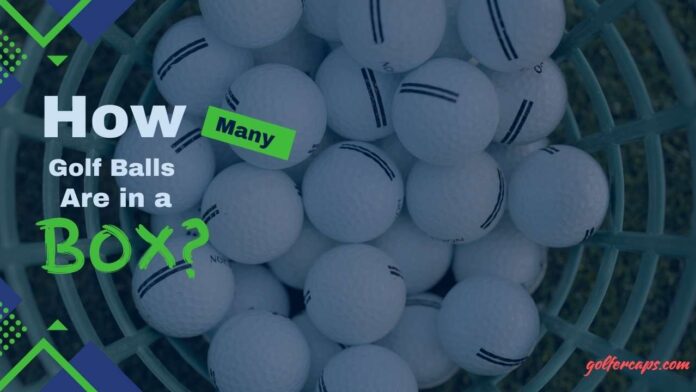Golf, a game beloved by many, requires the right equipment for a satisfying play experience. Among the essential items in a golfer’s kit is, of course, the golf ball. But have you ever wondered how many golf balls are in a box? Whether you’re stocking up for the season or preparing for a tournament, understanding the quantity of golf balls in a box is crucial. In this article, we’ll delve into the factors determining the number of golf balls in a box, industry standards, and useful buying strategies.
How many golf balls do you get in a box?

How many golf balls in a large bucket?

The number of golf balls in a large bucket isn’t fixed, but there’s a good estimate based on typical bucket sizes:
- Large Driving Range Baskets: These often hold around 100-110 golf balls.
- General Estimate: Considering large buckets hold multiple dozens of balls, a reasonable estimate would be around 3 times the number in a box, which is roughly 36 golf balls (12 balls/box * 3).
It’s important to note that the actual number can vary depending on the specific bucket size and how tightly the balls are packed.
How many golf balls come in a sleeve?

Standard Golf Ball Quantities
When it comes to purchasing golf balls, you’ll encounter different packaging sizes depending on the brand and type. However, there are standard quantities that most manufacturers adhere to. A typical box of golf balls usually contains a dozen balls, though some brands offer packs of 15 or even 18 balls. Understanding these standard quantities helps golfers make informed decisions when purchasing their preferred brand.
Factors Affecting Golf Ball Quantity

When it comes to purchasing golf balls, understanding the various factors that can affect the quantity per box is essential. From packaging variations to customization preferences, several elements influence the number of golf balls you’ll find in a box. Let’s explore these factors in detail:
1. Packaging Variations:
- Different brands and product lines may offer golf balls in various packaging configurations. While some brands stick to the standard dozen balls per box, others may opt for packs containing 15, 18, or even 24 balls. These packaging variations cater to different consumer preferences and playing needs.
2. Bulk Purchasing Options:
- Golfers who prefer to buy in bulk often have the advantage of greater flexibility in packaging quantities. Manufacturers and retailers may offer bulk purchasing options where golf balls can be bought in larger quantities, such as packs of multiple dozens or even cases containing hundreds of balls. Bulk buying usually comes with discounted prices per ball, making it an attractive option for avid golfers.
3. Customization Preferences:
- Personalization and customization have become increasingly popular in the golf ball market. Golfers often have the option to customize their balls with logos, initials, or specific designs. When opting for customized golf balls, the quantity per box may vary depending on the manufacturer’s specifications and production processes. Some brands may offer personalized balls in standard packaging, while others may package them differently to accommodate customization requirements.
4. Special Editions and Promotions:
- Manufacturers occasionally release special edition golf ball sets or promotional packs that deviate from standard packaging quantities. These special editions may include unique designs, commemorative features, or bonus items alongside the golf balls. While these packs may offer a different quantity per box compared to regular offerings, they often attract collectors and enthusiasts seeking exclusive merchandise.
5. Packaging Efficiency and Cost Considerations:
- From a manufacturing and logistical standpoint, packaging efficiency plays a crucial role in determining the quantity of golf balls per box. Manufacturers aim to optimize packaging sizes and configurations to minimize waste and transportation costs while ensuring product protection and presentation. Factors such as box dimensions, material usage, and production processes influence the final packaging design and, consequently, the quantity of golf balls that can fit inside each box.
Calculating Golf Balls per Box

Determining the number of golf balls in a box is a straightforward process that involves basic arithmetic. Whether you’re stocking up for your next round of golf or planning a bulk purchase, knowing how to calculate the quantity per box ensures you get the right amount for your needs. Here’s a simple guide to help you calculate golf balls per box:
1. Determine the Total Number of Golf Balls:
Start by identifying the total number of golf balls you intend to purchase or have on hand. This could be based on your playing frequency, tournament requirements, or promotional needs.
2. Identify Packaging Size:
Check the packaging size specified by the manufacturer or retailer. Standard packaging typically includes boxes containing a dozen (12) golf balls, but variations may exist, such as packs of 15, 18, or 24 balls.
3. Apply the Division Formula:
Divide the total number of golf balls by the number of balls per box to calculate the number of boxes needed. Use the following formula:
Number of Boxes = Total Number of Golf Balls ÷ Number of Balls per Box
4. Example Calculation:
Let’s say you’re purchasing 60 golf balls, and each box contains a dozen balls (12 balls per box):
Number of Boxes = 60 ÷ 12 = 5 Boxes
5. Interpretation:
In this example, if you purchase 60 golf balls, you would need five boxes to accommodate them all. This calculation ensures you receive the desired quantity of golf balls without over or underestimating your needs.
6. Consideration for Non-Standard Packaging:
If you’re dealing with non-standard packaging sizes, such as packs containing 15 or 18 balls, adjust the division accordingly. For instance, if each box contains 15 balls, divide the total number of golf balls by 15 to determine the required number of boxes.
7. Plan for Bulk Purchases:
When buying golf balls in bulk, consider the potential savings and storage requirements. Bulk purchasing options often offer discounted prices per ball, making them cost-effective for avid golfers or organizations stocking up for events.
Industry Standards and Regulations
In the golf ball industry, there are stringent regulations governing packaging and labeling to ensure transparency and consumer confidence. Manufacturers must comply with these standards, which specify requirements for packaging materials, labeling accuracy, and quality control measures. By adhering to industry regulations, golf ball manufacturers uphold product integrity and promote fair competition in the market.
Buying Strategies
When it comes to purchasing golf balls, adopting effective buying strategies ensures you get the best value for your money and the right balls to enhance your game. Whether you’re a casual player stocking up for the season or a competitive golfer seeking high-performance options, these buying strategies will help you make informed decisions:
1. Assess Your Needs:
Determine your playing frequency, skill level, and performance requirements to identify the type of golf balls best suited to your game. Consider factors such as distance, spin, and feel to match the balls to your playing style and preferences.
2. Research Brands and Models:
Explore the wide range of golf ball brands and models available in the market. Research their features, performance characteristics, and customer reviews to narrow down your options and find the balls that meet your specific requirements.
3. Consider Budget and Value:
Set a budget for your golf ball purchase and weigh the cost against the value and performance benefits offered by different brands and models. While premium balls may offer advanced features, budget-friendly options can provide excellent performance at a lower price point.
4. Take Advantage of Bulk Buying:
Consider purchasing golf balls in bulk to enjoy cost savings and convenience, especially if you’re a frequent player or organizing events. Many retailers offer discounts for bulk purchases, allowing you to stock up on your favorite balls without breaking the bank.
5. Explore Promotional Offers:
Keep an eye out for promotional offers, discounts, and special deals from golf ball manufacturers and retailers. These promotions may include buy-one-get-one-free offers, bundle deals, or limited-time discounts, providing opportunities to save on your purchase.
6. Test Before You Buy:
Whenever possible, test different golf ball models on the course or at a driving range to assess their performance and suitability for your game. Testing allows you to experience firsthand how different balls feel and perform, helping you make an informed decision.
7. Consider Customization Options:
Explore customization options offered by golf ball manufacturers to personalize your balls with logos, initials, or specific designs. Customized balls not only add a personal touch but also make great gifts and promotional items for events and tournaments.
8. Seek Professional Advice:
Consult with golf professionals, instructors, or experienced players for recommendations on golf ball selection. Their expertise and insights can help you navigate the vast array of options available and find the balls that best complement your game.
9. Pay Attention to Seasonal Sales:
Take advantage of seasonal sales and clearance events to score great deals on golf balls and accessories. Retailers often offer discounts on the previous season’s inventory or holiday specials, providing opportunities to stock up on essentials at discounted prices.
10. Prioritize Quality and Performance:
While cost considerations are important, prioritize quality and performance when selecting golf balls. Choose balls that offer the right combination of distance, control, and feel to optimize your performance on the course and enhance your overall golfing experience.
Storage and Transportation Considerations
Proper storage and transportation of golf ball boxes are essential to maintain their quality and performance over time. Whether you’re storing them at home, in a clubhouse, or transporting them to a golf course, following these considerations ensures your golf balls remain in optimal condition:
1. Temperature and Humidity Control:
Store golf ball boxes in a cool, dry environment away from extreme temperatures and humidity. Exposure to heat and moisture can affect the materials and performance of the balls, leading to degradation and loss of resilience.
2. Avoid Direct Sunlight:
Sunlight exposure can damage golf ball covers and affect their durability and aerodynamic properties. Store boxes away from windows or direct sunlight to prevent discoloration and deterioration of the balls.
3. Use Protective Packaging:
When transporting golf ball boxes, use protective packaging such as padded bags or cases to cushion them against impact and vibration. This helps prevent damage to the balls and ensures they arrive at their destination in optimal condition.
4. Secure Storage Containers:
Invest in sturdy storage containers or cabinets specifically designed for golf equipment. These containers provide a secure and organized storage solution, protecting golf ball boxes from dust, moisture, and potential damage.
5. Rotate Stock Regularly:
If you have a large inventory of golf balls, practice stock rotation to ensure older batches are used first. This prevents balls from sitting idle for extended periods, which can lead to deterioration and loss of performance.
6. Consider Environmental Factors:
Be mindful of environmental factors such as temperature fluctuations, humidity levels, and exposure to chemicals or pollutants. Store golf ball boxes away from areas prone to moisture buildup or air pollution to maintain their quality.
7. Labeling and Organization:
Label golf ball boxes with relevant information such as purchase date, brand, and ball type to facilitate easy identification and inventory management. Organize boxes systematically to streamline access and minimize handling.
8. Inspect for Damage:
Regularly inspect golf ball boxes for any signs of damage, including dents, tears, or punctures. Damaged packaging can compromise the integrity of the balls inside and may require immediate attention or replacement.
9. Consider Climate-Controlled Storage:
In regions with extreme climates or seasonal variations, consider investing in climate-controlled storage solutions. Climate-controlled environments maintain stable temperature and humidity levels, providing optimal conditions for storing golf balls year-round.
10. Follow Manufacturer Guidelines:
Adhere to any specific storage and transportation guidelines provided by the golf ball manufacturer. Manufacturers often include recommendations for optimal storage conditions to maximize the lifespan and performance of their products.
FAQs:
- How many golf balls come in a standard box?
- Most standard golf ball boxes contain a dozen balls, though quantities may vary depending on the brand.
- Can I purchase golf balls in bulk?
- Many retailers offer bulk purchasing options, allowing golfers to buy larger quantities at discounted prices.
- Do personalized golf balls come in standard packaging?
- Personalized golf balls may be packaged differently depending on the manufacturer’s specifications, but they typically adhere to industry standards.
- What should I consider when buying golf balls in bulk?
- Factors to consider include pricing, brand reputation, and the golfer’s individual preferences and playing style.
- How should I store golf ball boxes to maintain their quality?
- Storing golf ball boxes in a cool, dry place away from extreme temperatures and humidity helps preserve their performance and durability.
Related content:










